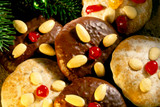Traditional German Lebkuchen: The Iconic Christmas Gingerbread Cookie

Lebkuchen — often called German “gingerbread” — are richly spiced holiday cookies made with nuts, candied fruits, and warm baking spices. These festive treats are among the most popular sweets of the Christmas season, cherished for their chewy, fragrant texture and deep, cozy flavor.
Lebkuchen has a long and storied past: the recipe was first developed more than a thousand years ago by monks in Central Europe. Working with what was available in the winter months — meager wheat, stored nuts, treasured “oriental” spices, and candied fruits — they created a heartwarming cookie that could keep through the cold season and bring sweetness to Advent and Christmas celebrations.
Read all about lebkuchen on www.germanfoods.org.
Shop Ready-to-Eat Lebkuchen and German Christmas Cookies
Click this link here and find the right fit for lebkuchen ready-to-eat:
-
Nuernberg Lebkuchen Rounds with chocolate, sugar glaze or with a wafer bottom
Classic Nürnberger Lebkuchen (Nuremberg-style gingerbread rounds), offered in traditional variations: coated in smooth chocolate, finished with a delicate sugar glaze, or baked on a thin wafer bottom for that authentic bite. -
Nuernberg Elisen Lebkuchen Rounds, the "Rolls-Royce" of its kind, with over 40% nuts and only the best ingredients
Elisen Lebkuchen are considered the premium standard of Nürnberger Lebkuchen. These luxurious rounds are high in nut content (often hazelnuts and almonds), low in flour, and intensely aromatic — truly a gift-worthy delicacy. -
Dresdner Dominosteine, cube shaped, with marzipan and/or cherry jam layers
Soft, layered confections from Dresden, usually built from spiced gingerbread-style base, fruit jam (often cherry), and marzipan, then enrobed in chocolate. A small cube with big holiday flavor. -
Aachener Printen, hearty gngerbreads from the former capital of the Charlesmagne's empire
Aachener Printen are robust, spiced gingerbreads from Aachen, a city famously tied to Charlemagne’s empire. This regional specialty is traditionally firm, dark, and richly flavored with caramelized sugar and aromatic spice. -
Cinnamon Stars
Zimtsterne (“cinnamon stars”) are classic almond-and-cinnamon cookies, cut into star shapes and topped with a snowy white glaze — a must on any German Christmas cookie plate. -
Pfeffernuesse
Pfeffernüsse are bite-sized spiced cookies whose name (“pepper nuts”) hints at their bold, peppery warmth. Typically dusted with powdered sugar or covered in a thin glaze. -
Lebkuchen Hearts, with sprinkles
Festive Lebkuchen hearts decorated with colorful sprinkles. These playful cookies are often found at Christmas markets and make sweet little gifts or stocking stuffers. -
Lebkuchen in Festive Tins, which make beautiful gifts, even after you ate all the lebkuchen inside.
Keepsake tins filled with assorted Lebkuchen and German Christmas cookies. The tins are charming to display or reuse long after the last cookie has (happily) disappeared.
These varieties allow for traditional German holiday gift-giving: some are beautifully packaged for sharing, while others are ideal for cookie plates, Advent gatherings, and St. Nicholas Day treats.
Bake Authentic Lebkuchen at Home
Homemade Lebkuchen brings the scent of Christmas into the kitchen: toasted nuts, candied citrus, honey, cinnamon, clove, cardamom, ginger. With the right German baking ingredients, the taste comes incredibly close to what bakeries in Nürnberg, Aachen, or Dresden produce.
Find all the essential flavor and baking aid ingredients to make and bake lebkuchen at home:
-
Lebkuchen Oblaten wafers
These thin baking wafers form the base for many traditional Lebkuchen. They help the cookies hold their shape and give that authentic bakery-style bottom. -
Hirschhornsalz (ammonium Carbonate, you need this to make the dough rise)
Hirschhornsalz is a classic German leavening agent. It creates a slightly airy, tender texture in old-world holiday cookies like Lebkuchen, Pfeffernüsse, and Springerle. -
Pottasche (potash; another raising agent)
Potash is a traditional leavener used in dense, spiced Christmas cookies. It helps the dough relax and spread just enough while staying chewy and moist. -
Gingerbread Spice Mix
A ready-to-use blend of holiday spices: often cinnamon, cloves, aniseed, cardamom, coriander, ginger, and allspice. This mix delivers the unmistakable German Lebkuchen aroma. -
Lemon and Orange Peel
Finely chopped, candied citrus peel is essential for real German-style Lebkuchen. The sweet bitterness from orange and lemon peel balances the richness of nuts, honey, and spice.
These pantry staples make it possible to recreate traditional German Christmas baking at home — from chewy Lebkuchen rounds to aromatic Pfeffernüsse.
Classic German Christmas Recipes to Try (and Share)
Baking is part of the ritual: tins on the counter, coffee or mulled wine nearby, and a plate of fresh cookies cooling on the table. Many of the most beloved German Christmas recipes build on the same themes of spice, nuts, marzipan, and delicate sweetness.
Find great recipes for:
-
Lebkuchen
German gingerbread cookies made with nuts, honey, candied peel, and warming spices; often glazed or dipped in chocolate. -
Stollen
The famous German Christmas loaf, rich with nuts, raisins, candied citrus, marzipan, and powdered sugar. Stollen is often enjoyed sliced thin with butter or a hot drink. -
Marzipan Cakes
Almond-paste treats and marzipan-topped cakes that highlight the smooth, sweet, almond-forward flavor that German holiday baking is known for. -
Vanilla Kipferl
Crescent-shaped vanilla-almond cookies rolled in vanilla sugar. Buttery, delicate, melt-in-the-mouth tender. -
Springerle
Anise-flavored embossed cookies, traditionally pressed with carved molds to leave intricate designs. A showcase of regional craft and patience. -
Christmas Cookies
A general assortment of traditional Plätzchen: spiced, nutty, jam-filled, almond-topped, sugar-dusted. Often baked in large batches for Advent Sundays, holiday markets, and gift boxes.
Together, these recipes (and the specialty ingredients above) form the backbone of a traditional German Christmas cookie assortment — the kind laid out on heirloom plates, brought to neighbors, and sent in festive tins.